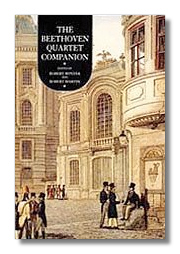Winter, Robert, & Martin, Robert (Eds.) (1994). The Beethoven Quartet Companion. Los Angeles: University of California Press, 300 pp.
There are few finer pleasures in life than to listen to a recording of Beethoven’s string quartets, while reading a book like this. Reading the book seems to flow in a different channel of the mind than the music does, yet each enriches the other.
I bought this book in preparation for a series of four lectures I signed up for at the University of Arizona. Those start about a month from now, but note well, people who say that the sole, or main purpose of a college education is preparation for the job market: You are wrong. There’s more to it than that. The higher purpose of education is to deepen one’s understanding of life in ways that are simply unimaginable to the ignorant.
This book is roughly divided into two parts. The first is a series of essays about the history and significance of the sixteen quartets, including information about Beethoven’s life and the culture of Vienna around 1800. This material is well-presented and fascinating for a non-musician like me. I learned, for example, that one reason the sixteen quartets are traditionally classified into early, middle and late clusters is because of changing economics and demographics in Vienna during that period. Just prior to 1800, audiences expected to recognize the classical structures of Haydn and Mozart, but by the early 1820’s, Napoleon had invaded, the aristocrats were broke, and the expectations of the listening audience were entirely different. Add to these changes, advances in instrument technology, which affected what could be played and what an audience could hear.
The three periods of the quartets are stunningly different. You can hear this clearly in the Emerson String Quartet’s excellent recording of sample quartets from each period, “Key to the Quartets” (Deutsche Gramophone). I was so taken by the mental, emotional, and spiritual differences between the periods that I once played this recording to a college class in developmental psychology to illustrate, in a non-verbal way, the stages of adult psychological development. Alas, the students could not grasp the idea, and now I realize it takes some time to learn how to listen to the quartets. You can’t just spring them on somebody. I was young.
After reading this book, I see that there were many changes, historical, political, economic, and technical, that contributed to the sound of the quartets in each of the three periods. Knowing that, I now have serious questions about another favorite recording, “A State of Wonder,” Glenn Gould playing the complete Goldberg Variations in 1955 and again in 1981 (Sony Classical). I have always heard the two recordings as representing the exuberance of youthful genius and the knowing wisdom of maturity. After reading this book about Beethoven’s string quartets, I’m no longer sure individual psychology ever tells the whole story of musical evolution.
The last two-thirds of this book are descriptive notes on each of the sixteen quartets. These include excerpts from the scores for illustration of the points being made. I am not able to read music well enough to appreciate those, to my regret, but the descriptive and analytic comments are highly accessible even to the non-musician and will enrich the listening experience.
The book also includes fascinating photographs, of period instruments, prominent musical figures of the time, letters, and even Beethoven’s original, incredibly messy, but astonishing, hand-inked sketches for some quartets. There is a very useful glossary of musical terms in the back, along with an index. I am very much looking forward to the U of A’s series of lectures on this topic.

